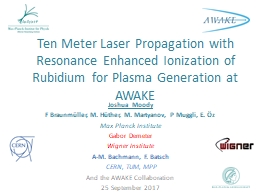

Joshua Moody F Braunmüller M Hüther M Martyanov P Muggli E Öz Max Planck Institute Gabor Demeter Wigner Institute AM Bachmann F Batsch CERN TUM MPP And the AWAKE Collaboration ID: 1044328
Download Presentation The PPT/PDF document "Ten Meter Laser Propagation with Resonan..." is the property of its rightful owner. Permission is granted to download and print the materials on this web site for personal, non-commercial use only, and to display it on your personal computer provided you do not modify the materials and that you retain all copyright notices contained in the materials. By downloading content from our website, you accept the terms of this agreement.
1. Ten Meter Laser Propagation with Resonance Enhanced Ionization of Rubidium for Plasma Generation at AWAKEJoshua MoodyF Braunmüller, M. Hüther, M. Martyanov, P Muggli, E. ÖzMax Planck InstituteGabor DemeterWigner InstituteA-M. Bachmann, F. Batsch CERN, TUM, MPPAnd the AWAKE Collaboration 25 September 2017
2. AWAKE stands for Advanced WAKefield ExperimentWhat is AWAKE?**See Patric Muggli’s plenary invited talk tomorrow at 9:50 for AWAKE overview and first experimental results***Proton driven wakefields over 10 meters of plasma Self modulation of proton beam driverSaturated wakefields are > 100MV/m
3. AWAKE Plasma Source10 meter rubidium vapor sourceRubidium is controlled to within .2% neutral density, gradients can be controlledVapor is photo-ionized by peak power 4.5 TW Ti:Sa laser See Erdem Öz ‘s presentation in WG5 for details
4. Photoionization Requirements for AWAKEIonization laser must do three things:Provide a singly ionized plasma from the Rb vapor that has a density profile identical to that of the vapor for the entire length of the vapor sourceThe radial extent of the plasma must be greater than trajectory of plasma electrons Seed self modulation by igniting on the plasma at a timescale at or shorter than the plasma period where the proton beam can drive the wakefields
5. Laser system in MPI, MunichLaser System Laser typeEr:Fiber/ OscillatorTi:SapphirePulse wavelengthl0 = 780 nmPulse length120 fs FWHMPulse energy (after compressor)450 mJLaser power4.5 TWFocused laser sizesx,y = 1 mmRayleigh length ZR~3.5 mEnergy stability±1.5% r.m.s.Repetition rate10 HzLaser Room MPP5TW LASER Laser Room at AWAKE Fiber laser chosen for stability on long runsLaser BW is only 15nm with peak spectrum at 780nmSeveral Rb lines within spectrum
6. Resonant TransitionsPrimary state path to ionizationResonant lines within laser bandwidth
7. Pulse Propagation in the “Linear Regime”Spectrum (arb)n-1Two resonances would cause anomalous dispersion, pulse stretching, etc. If it is different across the beam then the beam can blow up, multifilament, etc. We can expect some behavior like this in the wings
8. High Intensity Laser pulse Leading edge of the pulse ionizes or saturates the transitionMost of the pulse travels through plasma, samples plasma dispersion, which has a differential index on the scale of 10-8If beam does not deplete, it can make it through without stretching or destroying mode quality, creating a stable sized plasma channel
9. AWAKE Experimental AreaVirtual LineDownstream Pickoff, LBDP3Final Laser mirrorVapor Source
10. Pickoff SetupAvoid nonlinearity in sampling by:Wedge picked off .5% of laser (close to Brewster’s angle)Mirror splits beam to autocorrelator or power meter and bleedthrough goes to transverse measurementTelescope images downstream iris of the vapor sourceWedgePower meter or AutocorrelatorCameraImaging irisMain limitations to setup:Power meter too insensitive below .5 mW (10 mJ energy hitting the wedge )Wedge will still burn if energy is increased above 250 mJOffline measurement (no protons)
11. Virtual Line ImagesInitial Conditions of Laser / Vacuum BehaviorVirtual EntranceVirtual CenterVirtual ExitPick off imaged here10m
12. Preliminary Propagation ResultsVacuumEn = 40 mJEn = 240 mJBeam Blowup, multifilamentationBeam StableEn = 60 mJEn = 55 mJRb n = 7e14 / cm3
13. Simulation ModelFurther extended to 2DLaser Pulse collapse“Slow pulse”G. Demeter
14. Preliminary Simulation ResultsI0: 40 TW/cm2I0: 3 TW/cm2Subthreshold:Ionization channel collapse,Output laser pulse destroyedSuper Threshold: Stable ionization channel,Stable laser outputG. Demeter
15. Propagation Confirmedbut Ionization?Preliminary!!!See for details:F. Batsch,K. Rieger,M. Martyanov,F. Braunmueller Self modulation frequency vs neutral density demonstrates consistency with complete ionization within uncertaintiesScaling!Value!AWAKE Typical run well above threshold energies: 200 mJ
16. Conclusions and OutlookConclusions:Experimental demonstration of laser propagation above and below channel collapse limitQualitative results of simulation match what is observed with experimental resultsMeasured self modulation frequency versus neutral density consistent with full ionizationA strength of resonance enhanced ionization is when laser depletion occurs ionization drops off sharply and a stable transverse laser mode fails to propagate out of plasma. This can serve as an diagnostic to ensure the plasma channel is the full length of the vapor sourceOutlook:Experimental program for ionization experiments thus far limited by higher priority needs of AWAKE (SM experiments, electron beam development)A program with quantitative systematic study scheduled for early next year including:Laser SpectrumTime resolved plasma light spectrum (A-M Bachmann, M. Martyanov)Energy depletion scalingPrecision neutral density dependenciesInput laser pulse length dependencies (chirped pulsing)Input transverse mode quality dependenciesFurther numerical model development to compare new results